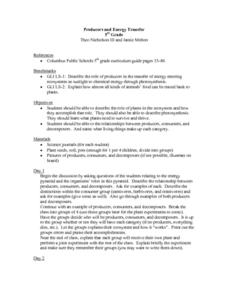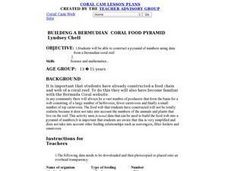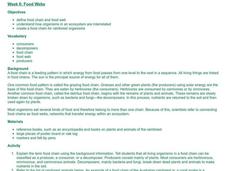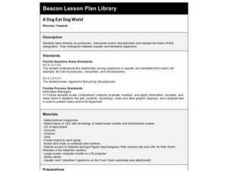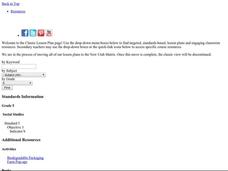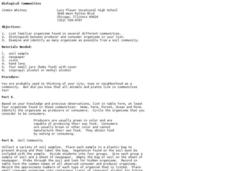Curated OER
The Mechanisms of Decay and Decomposition
Eighth graders study how all living things die. They are introduced tot he life cycle and the concept of an ecosystem. Students have a introductory exposure to trophic levels (producer-consumer-decomposer) in the environment.
Curated OER
Recyclers to the Rescue
Fifth graders examine the concept of the food chain and define producer, consumer, herbivore, carnivore, and omnivore. They draw a food chain for a mouse and discuss the different organisms involved in the chain, and conduct an...
Curated OER
An Introduction to the Ocean World
Students comprehend how the organisms that exist within the ocean biome, and categorizing each into producer, consumer, or decomposer. They place various human actions under the headings of "hazard" or "help," illustrating how humans can...
Curated OER
Producers and Energy Transfer
Fifth graders discuss the relationship between producers, consumers, and decomposers as they look at the energy pyramid. While working in small groups, they create an ecosystem that includes all or some of the given categories, and they...
Curated OER
Lemonade Stand
Students plan a lemonade stand to compete with another stand and examine their decisions from the consumer and producer's point of view. They discuss the law of supply and demand, plan for their lemonade stand, and write an essay...
Curated OER
Producers of Goods and Services
Students use newspapers to brainstorm a list of the producers of goods and services in their community. In groups, they organize coupons based on the good or service and create a chart to organize the information. They discuss the...
Curated OER
Resources
Students watch a video in which they tour a factory. While viewing the video, they take notes on the types of resources they see and group them according to natural, human or capital resources. They discover the difference between...
Curated OER
What is Economics?
Students define economics; Explain the importance and process of making economic choices and decisions; Identify the factors of Production; Determine the goal of entrepreneurship. Students identify and describe the difficulties...
Curated OER
Arctic Food Web
Students research animals found in the arctic. They discuss what living things need in order to survive and where they get their food. Students discuss the difference between producers and consumers and create a food web for animals in...
Curated OER
Science: Coral Reef Food Pyramid
Learners construct numbers pyramids using fictional data from a coral reef. they tally the numbers of carnivores, herbivores, and producers. Students next build a pyramid shape in which they put their numbers of producers, herbivores,...
Curated OER
The Flow of Energy Song
Students perform the lyrics and instrumental parts for the "Flow of Energy song." They create photo images which represent consumers, producers, decomposers, and scavengers. These images will be inserted in an iMovie of the class...
Curated OER
Food Webs
Students research rainforest animals and use that information to make a flow chart to show the order in which energy is transferred through several organisms. They label the producers, consumers, and decomposers in their chart.
Curated OER
Time, Talent, Treasure and Economics
Students work cooperatively to create a quilt. They choose a pattern and determine the specific skills and steps needed to produce that quilt. Labor is divided equally between group members and a quilt is created assembly line style....
Curated OER
Insect Travel Brochure
Seventh graders study producers and consumers in habitats. They examine the trophic levels and how different organisms interact with a focus on insects. They create a travel brochure for an insect to visit a habitat which they create.
Curated OER
A Dog Eat Dog World
Fourth graders distinguish between acquatic and terrestrial organisms. They label animals as producers, consumers, and/or decomposers.
Curated OER
Who Is Eating Whom?
Students discuss the food chain and identify if various organisms are producers or consumers. They draw ten types of organisms and construct a food web of these organisms, labelling each as a producer or consumer.
Curated OER
Producers and Consumers
Third graders identify the relationship between producers and consumers and supply and demand. They listen to a lecture and complete a variety of graphic organizers to show their understanding.
Curated OER
Constructing A Food Web
Students identify and explain the relationships within a food web. They use index cards to glue pictures of producers and consumers. On the back of the card, students name the organism, list the type of biome in which it is found.
Curated OER
Food Chains and Webs
Students identify the organisms found near their school or house and observe them. In this food chain lesson students examine how an organism gets their energy and then fill in a chart to create a food web with the organisms they listed.
Curated OER
Source Search
Fifth graders discover how agriculture affects our daily lives. In this agriculture lesson plan, 5th graders investigate different products that originate from agriculture. Resources are provided.
Curated OER
Capital for Cookies
Fourth graders examine the history of Utah's economy. In this Social Studies lesson, 4th graders analyze producers and consumers role in the community. Students study Utah's economy throughout history.
Curated OER
Strands Walk An Ecological Observation
Students examine an ecosystem and analyze the role of two abiotic factors in the ecosystem. In this ecosystem lesson students complete an activity on their ecosystem.
Curated OER
Little Sprout
Students plant seeds. In this producers lesson, students compare plants and list what they have in common. They discuss what plants need in order to grow. Students then plant seeds and observe them as they grow.
Curated OER
Biological Communities
Pupils identify consumers and producers in different communities. Students collect a variety of soil samples and record organisms found in the samples.





